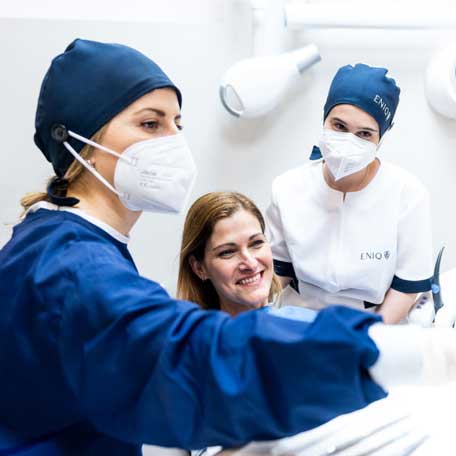

Child Dental Aesthetics
Safe and fun treatments for radiant children's smiles.
What is Aesthetic Dentistry in Children?
Aesthetic dentistry in children refers to dental procedures aimed at improving the aesthetic appearance of a child's smile and teeth. Unlike aesthetic dentistry in adults, aesthetic dentistry in children focuses on the specific dental needs and characteristics of children and is adapted to their age and development.
Some of the aspects addressed in aesthetic dentistry in children include:
- Teeth Whitening: Used to lighten teeth and remove stains or discoloration caused by foods, drinks, or certain medications. However, teeth whitening is generally recommended for older children or teenagers, once their permanent teeth have fully erupted.
- Aesthetic Restorations: Used to repair damaged or decayed teeth using materials that match the natural color and appearance of teeth. These restorations include white fillings (composite resins) and porcelain or composite resin crowns.
- Aesthetic Orthodontics: Refers to orthodontic treatments focused on improving the alignment and appearance of children's teeth. This may include the use of ceramic braces or clear aligners, such as Invisalign Teen, to correct malocclusion or crowded teeth.
- Restoration of Damaged Teeth: In cases of traumatized or fractured teeth, restoration procedures can be performed to improve the tooth's appearance and restore its function.
- Facial Aesthetic Evaluation: Pediatric dental specialists also evaluate facial aesthetic harmony in children, considering aspects like the balance of facial features and the smile.
It's important to highlight that while aesthetics is an important component in dentistry for children, function and dental health are always a priority. Aesthetic treatments are conducted within the framework of maintaining oral health and proper development of teeth and jaws in children. If you're interested in learning more about aesthetic dentistry in children, it's advisable to consult with a dentist or pediatric dentist for an evaluation and specific recommendations for your child.
Process
What is the procedure for making crowns and aesthetic inlays in children?
The process of making crowns and aesthetic inlays in children generally involves several stages. Below, I will describe the typical steps followed in the process:

General Process of Dental Inlays and Crowns in Children:
At ENIQ, we have technology that allows us to reduce the necessary steps for treatment from six to three, resulting in fewer appointments needed to complete it. The process now consists of:
- A first diagnostic visit.
- A second visit for digital capture.
- A third visit for the placement of the restoration or crown on the patient.
- Evaluation and Planning: On the first visit, the dentist will perform a comprehensive evaluation of the child's teeth and determine if a crown or an aesthetic inlay is necessary. X-rays and other tests will be taken if needed. The dentist will discuss the treatment plan with the parents and explain the details of the procedure.
- Preparation of the Tooth: On the next visit, the dentist will prepare the tooth to receive the crown or aesthetic inlay. This involves shaping the tooth to create space for the restorative material. The dentist will remove any decay or damaged dental structure. Sometimes, local anesthesia may be required to ensure the child is comfortable during the procedure.
- Taking Impressions: Once the tooth is prepared, impressions of the child's teeth will be taken using dental impression materials. These impressions will be sent to the dental laboratory so the dental technician can custom-make the crown or aesthetic inlay.
- Placement of a Temporary Crown: While the custom crown or inlay is being made in the dental lab, a temporary crown or restoration will be placed on the child's tooth to protect it and maintain aesthetic and masticatory function.
- Placement of the Crown or Aesthetic Inlay: On the final visit, when the crown or inlay is ready, the dentist will place it on the child's tooth. It will be adjusted and the fit and aesthetics will be checked. The restorative material will be bonded to the tooth with special dental cement and polished to achieve a smooth, natural finish.
- Follow-up and Post-Care: After the crown or inlay is placed, the dentist will provide instructions on proper care, including oral hygiene and regular follow-up appointments. It's important for the child to maintain good oral hygiene and avoid harmful habits, such as biting hard objects or chewing ice, to prolong the lifespan of the restoration.

What is the best option for a child: a metal crown or a white filling?
The choice between a metal crown and a white filling for a child depends on several factors, including the condition of the tooth, the extent of decay or dental damage, the location of the tooth in the mouth, and the specific needs of the patient.
Below, I provide information about each option:
- Metal Crown: Metal crowns are highly durable and strong, making them particularly suitable for back teeth that endure intense chewing forces. They are relatively inexpensive and can be placed in a single visit. Metal crowns are a common choice for baby teeth, as these will be replaced by permanent teeth in the future. However, they may be less aesthetically pleasing than other options due to their visible metallic color.
- White Filling: White fillings, also known as composite resin fillings, are tooth-colored dental restorations used to treat cavities or damage in teeth. Aesthetically, they are more pleasing than metal crowns, as they can be matched to the natural color of the teeth. However, white fillings may not be as durable as metal crowns and can wear down or fracture over time, especially in back teeth subjected to intense chewing forces.
The choice between a metal crown and a white filling depends on the evaluation and recommendation of a dentist or pediatric dental specialist. Generally, metal crowns are used when the damage or decay is extensive and compromises the tooth's structure, while white fillings may be more suitable for less extensive cavities or damage.
It is important to consult a dental professional to assess the child's case and provide a personalized recommendation. The dentist will consider the child's dental health, tooth location, and other relevant factors to make an informed decision and ensure the most appropriate and successful treatment.
What are the benefits of performing aesthetic treatments for children at ENIQ?
Aesthetic treatments for children using technology can offer a number of benefits. Some of them include:
- Superior Aesthetic Results: Current technology in aesthetic dentistry allows for superior aesthetic results, using advanced materials and techniques that offer a more natural and attractive appearance. This is especially important for children, as a healthy and aesthetically pleasing smile can boost their confidence and self-esteem.
- Greater Precision and Fit: Digital technologies, such as intraoral scanning and computer-assisted design (CAD), enable precise measurements and records of the child's teeth and mouth. This facilitates the creation of customized restorations that fit perfectly to the child's dental structure, resulting in greater comfort and functionality.
- Less Invasive Procedures: Some technologies allow for more conservative and less invasive treatments. For example, using dental lasers can precisely remove decayed tissue in a minimally invasive way, preserving as much healthy dental tissue as possible. This reduces the need for anesthesia and enhances the child's experience during treatment.
- Reduced Treatment Time: Technologies like digital orthodontic systems or clear aligners can speed up the process of correcting dental alignment compared to conventional methods. Additionally, the use of digital technologies can streamline the impression taking and restoration manufacturing, reducing the number of required appointments and shortening the overall treatment time.
- More Comfortable Experience: Modern technologies in dentistry often provide a more comfortable experience for the child. For instance, computerized anesthesia systems allow for more precise and controlled administration of anesthesia, reducing discomfort during procedures. Additionally, some technologies offer more comfortable and aesthetic options, such as ceramic brackets or clear aligners, compared to traditional orthodontic appliances.
It's important to highlight that each specific technology may have its own benefits and limitations, and not all clinical cases will be suitable for all technologies. Therefore, it's advisable to consult with a specialized dentist or pediatric dentist, who can evaluate the child's dental situation and recommend the most suitable aesthetic treatment options, taking into account the advantages and specific considerations of each available technology.
What is the price of aesthetic dentistry for children?
The price of aesthetic dentistry for children in Spain can vary depending on various factors, such as geographic location, dental clinic, the type of aesthetic treatment performed, and the specific needs of each child. Prices can also vary based on the experience and reputation of the dentist or pediatric dental specialist.
In general, aesthetic treatments for children, like aesthetic fillings, teeth whitening, dental veneers, or correction of dental position with aesthetic orthodontics, can have a range of prices. To give you an approximate idea, here are some average price ranges in Spain:
- Aesthetic Fillings (Composite Resin): Prices can vary depending on the size and complexity of the restoration. The average cost can range from 50€ to 150€ per tooth.
- Teeth Whitening: The price of teeth whitening for children can be in the range of 150€ to 300€, depending on the type of whitening used and the extent of the treatment.
- Dental Veneers: The cost of dental veneers can vary based on the material used and the number of veneers needed. The average price can be around 250€ per dental veneer.
- Aesthetic Orthodontics: The cost of aesthetic orthodontics in children will depend on the type of treatment used (such as ceramic braces or clear aligners) and the duration of the treatment. Prices can range between 1,500€ and 5,000€, or even more, depending on each case.
It's important to keep in mind that these prices are only estimates and can vary considerably. I would recommend that you directly consult dental clinics or pediatric dental specialists in your area for an accurate assessment and specific quote for the aesthetic treatment your child needs.
Aesthetic Treatments for Children
Caring for the little ones
*subject to specialist evaluation
-
All-inclusive
Frequently Asked Questions
Do you have more questions about dental aesthetics in children?
Dental aesthetic treatments can be considered once the permanent teeth have fully erupted, usually around 6-7 years old. However, the specific timing depends on the dentist's evaluation and the individual needs of the child.
Aesthetic treatments are designed to preserve the natural structure and, in many cases, help maintain healthy dental and facial growth.
Services
All rights reserved © ENIQ Clinic 2025
Legal Notice · Privacy Policy · Cookie Policy
